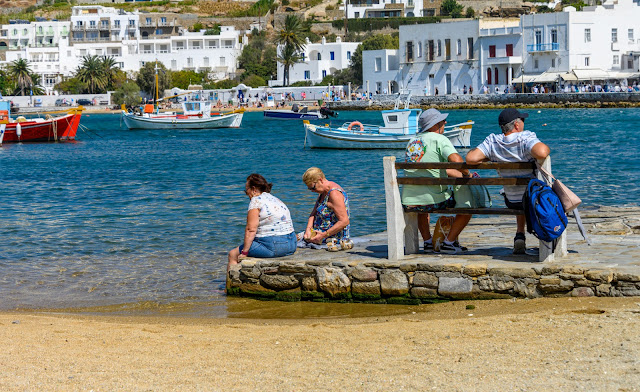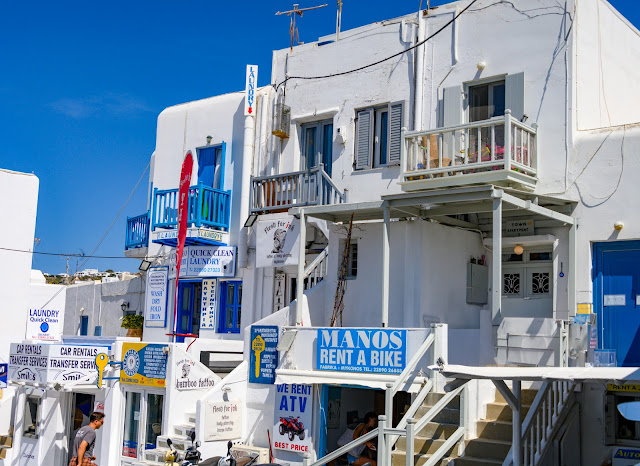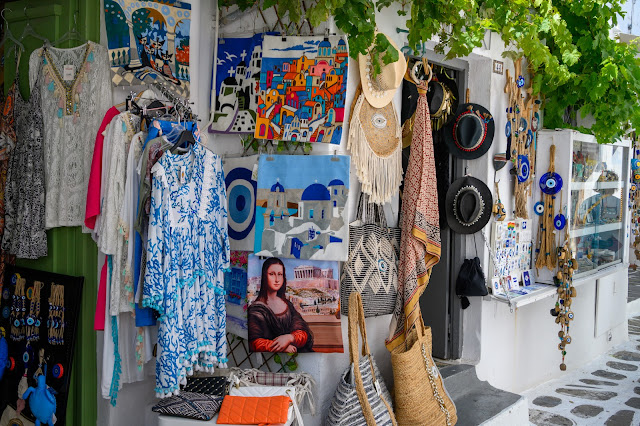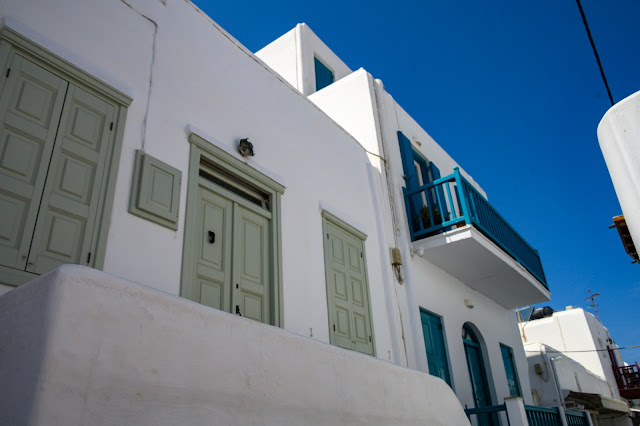The primary religion in Mykonos is Greek Orthodox, with over 80% of the population identifying as a member of the church and anyone coming to Mykonos will certainly stumble upon many of these buildings devoted to religious contemplation.
If you recall from previous post, there are approximately 1200 churches and places of worship around the island. However we chose to visit only a couple of them.
The first one was located in the small town of Agios Ioannis. This small church is built on the hill overlooking the beach. It is one of the most privileged places of Mykonos Island because of the stunning view to the sacred island of Delos.
A thirty minute drive through narrow, steep roads.....
......and we were in Ano Mera. Located in this small town in Mykonos, is the Monastery of Tourliani.
"The monastery of Panagia Tourliani was originally built in 1542 by two priests and was initially named after the Presentation of the Virgin Mary. It was restored in 1767 and took its present name after an icon of the Virgin Mary found in the nearby area of Tourlos. From then, Panagia Tourliani became the patroness of the island and is celebrated on August, 15th. The architecture of the monastery is rather impressive, with a whitewashed exterior and a colored dome. In the interior of the church is an impressive wooden iconostasis (altar screen) made in 1775 by Florentine artists. There are icons of apostles and saints on the iconostasis as well as scenes from the New Testament. The screen is decorated with green, red and golden flowers. The hanging incense holders are decorated with silver dragons having red eggs in their mouth, which show the Eastern influence. "
I know these next few photos have nothing to do with the monastery except for the location. But these guys just seemed to own the place, therefore candids were required.
Of course when you are tourist you have to do touristic stuff. Therefore, since Mykonos is known for it's gorgeous beaches and azure blue waters, we had to experience some of that notoriety.
Stopping at the Agrari beach was a must!
Naturally, a beach with a cocktail bar and food, requires a sit down and a guzzle.
I should mention that Agrari Beach is very popular with locals because of its long sandy beaches and its distance away from the "chora" (town).
Moving on forward, next stop is the Agios Nikolaos Church. A small Orthodox Church built around 1700 in honor of Saint Nicholas, the protector of sailors and fishermen.
The church is located in the Old Port of Mykonos Town, located very close to Manto Mavrogenous Square.
The square is dedicated to Manto Mavorgenous, the beautiful female commander of Mykonos who helped change the course of history in Greece. Magdalena "Manto" Mavrogenous was an aristocratic woman who donated all her money to fund the War of Independence in 1821. In addition, she led military expeditions and was credited with causing the Turks to retreat.
"A memorial to Manto Mavrogenous is located in the heart of the square. A larger-than-life bust of her head rests upon a seven-foot-tall pedestal made from marble. It is surrounded by two-foot tall stone fencing that is short enough to allow visitors to pay tribute but doesn't allow them to come close enough to cause damage to the statue. The pedestal is inscribed with her name."
The map below, sitting aroound the old port, was made for tourists. It not only shows the various areas on the island but also points out the "clickable" sites.
But one does not have to move far off the public square to notice the major attractions. On one side are the iconic windmills, know as Kato Windmills.
At one time there were 28 windmills around Mykonos, now there are only 16, of which seven of them ( I was only able to capture four in this photo, lens was not wide enough) stand on a hill facing north taking advantage of the north wind.
And on another side is Little Venice.
Mykonos' Little Venice, was first named Alefkandra due to it's proximity to Alefkandra beach, a picturesque beach in the area. Unlike most buildings in Greece that utilize the bright, whitewashed Cycladic architecture, many of the homes in Little Venice are vibrant and colorful. They have adopted traditional Venetian architecture, with typical arches and wooden balconies.Venetian influence began in the 13th century when the island was part of the Venetian trade route. Mykonos was often the spot where sailors would stop to rest and dine. This practice continued through the 18th century.
Today, Little Venice is a bustling little town and a major atrraction for visiting sightseers.There are numerous shops, bars, clubs, and cafes, that populate the area, necessitating, visitors like us, to walk the area and take in the sites.

As we walked through the labyrinth of streets and especially through one of the most famous streets in Mykonos, Matoyianni, known as the shopholic's haven, we approached another iconic church.
The lovely church of Panagia (the Virgin Mary) Paraportiani.
This particular church is among the most photographed churches on the island. Since its entrance was located near the side gate of the entrance to the Kastro neighborhood, its name literally translates to “Our Lady of the Side Gate” in Greek.
Again, I end the tour of another Greek Island, leaving you with one last advise...... If the opportunity arises for you to visit Mykonos....grab it!
Ohhhh..... I saw these guys as we were driving around, had to capture!😊😊
Next stop has numerous gates and forts, quite medievalish...can you guess which island that is?
Hint➡️➡️➡️➡️ Ρόδος
😉😉


































































































































Great pictures Camellia, they really give a flavour of a place and they certainly know how to decorate their churches out there don't they. Only 1198 to go then😉
ReplyDelete😂😂If I'd known you would be counting, I'd kept my mouth shut. But seriously thank you. I agree they sure do know how to decorate their churches and you'll see as I post the 1198th photo that they are not the only ones with a decorative eye 😉
Delete